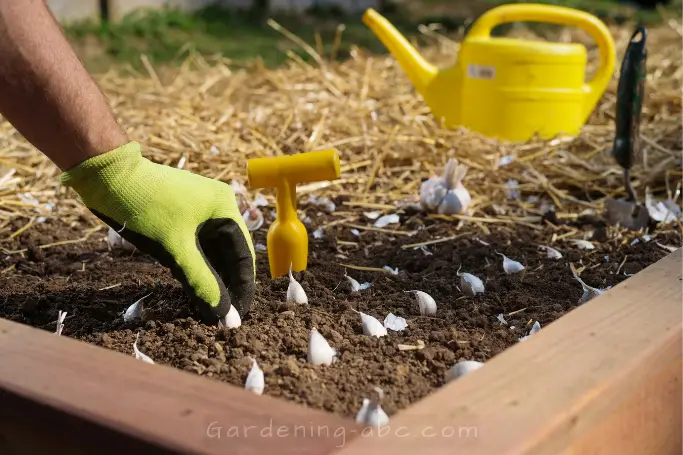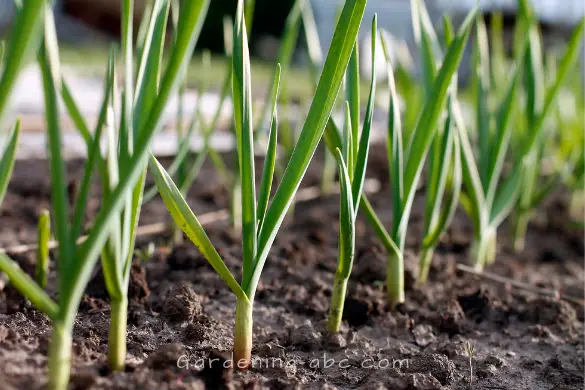We use affiliate links to run our site. When you buy through links on our site, we may earn an affiliate commission, without any added cost to you. Learn more
Garlic (Allium sativum) is a remarkable plant that offers numerous benefits to its neighboring plants. Not only does it deter pests, but it also provides sulfur, a natural fungicide. As a result, garlic is widely used as a companion plant in gardens.
In this article, we will explore the best and worst companion plants for garlic, providing you with valuable insights to maximize the health and productivity of your garden.
Understanding Companion Planting
Companion planting is a time-honored practice in which species are strategically placed near each other to harness mutual benefits that promote optimal growth. By capitalizing on nature’s synergies, gardeners can create a harmonious ecosystem that deters pests, improves soil fertility, and enhances crop yields.
We gardeners often employ companion planting as an alternative to heavy chemical pesticide use. By harnessing the power of natural plant interactions, you can safeguard your crops while nurturing a thriving and sustainable garden.
The Benefits of Garlic as a Companion Plant
Garlic possesses a wide range of benefits that make it an excellent companion plant for various species. Its pungent aroma and potent compounds act as natural deterrents against many common pests, including aphids, spider mites, fungus gnats, Japanese beetles, snails, and cabbage loopers.
By planting garlic alongside other plants, you create a natural defense system that helps protect them from these destructive invaders.
In addition to its pest-deterrent properties, garlic also accumulates sulfur, a naturally occurring fungicide. This sulfur content provides protection against fungal diseases that can ravage your garden.
By incorporating garlic into your garden layout, you can proactively ward off fungal infections and safeguard the health of your plants.
Moreover, garlic’s aromatic profile extends its protective influence beyond insects. Gnawing pests like deer and rabbits are also deterred by the presence of garlic, making it an invaluable addition to your garden arsenal.
The adaptability of garlic is another advantage, as it can thrive in various soil types and environmental conditions as long as there is ample sunlight.
Best Companion Plants for Garlic
When selecting companion plants for garlic, it is crucial to choose species that not only coexist harmoniously but also enhance each other’s growth and vitality.
Here are some recommended companion plants for garlic based on their beneficial interactions:
Fruits and Vegetables
- Fruit trees (all): Garlic’s pest-deterrent properties can shield fruit trees from harmful insects, promoting healthier growth and higher yields.
- Tomatoes: Planting garlic near tomatoes helps repel pests like aphids and spider mites, while garlic benefits from the tomatoes’ ability to repel nematodes.
- Peppers: Garlic acts as a natural deterrent against aphids and other pests that commonly affect pepper plants.
- Eggplant: Garlic’s pest-repelling qualities extend to eggplants, protecting them from common invaders.
- Potatoes: When planted alongside garlic, potatoes benefit from their pest-deterrent properties and improved resistance to fungal diseases.
- Cabbage: Garlic helps ward off cabbage pests, including cabbage loopers and cabbage worms, promoting healthier growth and protecting against damage.
- Broccoli: Planting garlic near broccoli helps deter pests like aphids, caterpillars, and flea beetles.
- Cauliflower: Garlic’s pest-repellent attributes also extend to cauliflower, shielding it from potential harm.
- Kale: Garlic complements kale by deterring pests like aphids and cabbage loopers, promoting healthier foliage.
- Kohlrabi: Planting garlic near kohlrabi provides protection against pests, ensuring the health and vigor of this vegetable.
- Carrots: Garlic helps repel pests that commonly target carrots, such as aphids and carrot flies.
- Dill: Dill and garlic make excellent companions, as dill attracts beneficial insects that prey on common garlic pests.
- Beets: Garlic’s pest-deterrent properties extend to beets, helping protect them from various harmful insects.
- Spinach: Garlic enhances spinach growth by deterring pests and preventing potential fungal diseases.
Flowers
Garlic’s beneficial effects are not limited to edible crops; it also positively impacts certain flowering plants. Consider planting the following flowers alongside garlic to capitalize on their synergistic relationship:
- Roses: Garlic acts as a natural deterrent against common rose pests like aphids, providing protection and promoting healthier blooms.
- Geraniums: Geraniums benefit from garlic’s pest-repellent properties, ensuring their vibrant and pest-free growth.
- Marigolds: Marigolds have natural nematode-repelling qualities, and when combined with garlic, they form a potent defense against pests.
- Nasturtiums: Garlic and nasturtiums make excellent companions, as both plants deter a wide range of pests, creating a mutually beneficial environment.
Plants That Assist Garlic
While garlic thrives in most situations, certain companion plants can further enhance its growth and overall health. Consider incorporating the following plants alongside garlic:
- Rue: Rue acts as a natural repellent for maggots, helping to protect garlic bulbs from infestation.
- Chamomile: Planting chamomile near garlic enhances its flavor and quality, making it a fantastic companion for culinary enthusiasts.
- Yarrow: Yarrow’s vibrant flowers attract beneficial insects that contribute to the overall health of garlic plants.
- Summer savory: Summer savory enhances the flavor of garlic and provides a protective barrier against pests.
Worst Companion Plants for Garlic
While garlic has numerous benefits as a companion plant, there are a few species that should be kept at a distance. Avoid planting garlic near the following vegetables, as they may stunt its growth:
- Beans: Garlic can hinder the growth of beans, so it is best to keep these two plants separate.
- Peas: Peas and garlic are not compatible companions, as their coexistence may lead to undesirable effects on both plants.
- Sage: Garlic and sage should be planted separately, as they may inhibit each other’s growth.
- Parsley: Parsley and garlic are not recommended to be grown in close proximity, as they may have negative effects on each other’s development.
- Asparagus: Asparagus and garlic are not ideal companions, as their growth patterns and nutritional requirements differ.
By being mindful of these companion planting recommendations, you can ensure the success of your garlic crop and the overall well-being of your garden.
Planting Techniques for Companion Plants

To make the most of companion planting with garlic, it’s important to employ suitable planting techniques. Here are some techniques you can use:
1. Interplanting
Interplanting involves planting companion plants between garlic rows or within the same bed. This technique maximizes space utilization and allows plants to benefit from each other’s presence.
2. Border Planting
Border planting involves creating a border around your garlic bed with companion plants. This helps deter pests and provides a visual appeal to your garden.
3. Trap Cropping
Trap cropping involves planting companion plants near garlic to attract pests away from the main crop. This helps protect the garlic from infestations.
4. Succession Planting
Succession planting involves planting companion plants that have different growth cycles alongside garlic. This ensures a continuous supply of fresh produce and maximizes the use of garden space.
Common Companion Planting Mistakes to Avoid
While companion planting can be highly beneficial, it’s important to be aware of common mistakes to ensure successful outcomes. Avoid the following pitfalls:
1. Incompatible Plants
Not all plants make good companions for garlic. Avoid pairing garlic with plants that have conflicting growth habits, nutrient requirements, or pest interactions. Do thorough research before selecting companion plants.
2. Improper Spacing
Proper spacing is crucial for companion planting. Avoid overcrowding plants, as this can lead to competition for resources and hinder growth.
3. Neglecting Soil Requirements
Different companion plants may have different soil requirements. Ensure that the soil conditions meet the needs of both garlic and its companions for optimal growth.
Additional Tips for Successful Companion Planting
To ensure successful companion planting for garlic, consider the following tips:
1. Rotate Companion Plants
Rotate companion plants each season to prevent soil nutrient depletion and minimize the risk of diseases. This helps maintain soil fertility and keeps pests and diseases at bay.
2. Attract Beneficial Insects
Encourage beneficial insects like ladybugs, lacewings, and bees to your garden by providing them with food sources and suitable habitats. These insects can help control pests and enhance pollination.
3. Practice Good Garden Hygiene
Maintain good garden hygiene by removing weeds, fallen leaves, and any diseased plants promptly. This helps prevent the spread of diseases and reduces the risk of pest infestations.
Can I plant garlic near tomatoes?
Planting garlic near tomatoes can be beneficial as garlic acts as a natural repellent for insects and pests that can affect tomato plants, such as aphids and spider mites. Garlic’s antibacterial and antifungal properties can also help prevent diseases like blight.
However, it’s important to provide adequate spacing between the plants to ensure good airflow and prevent overcrowding.
Are there any plants that repel pests from garlic?
Yes, certain companion plants like marigolds, lavender, and nasturtiums can repel pests that commonly affect garlic, such as aphids and nematodes.
What herbs can be planted alongside garlic?
Basil, rosemary, and thyme are herbs that can be planted alongside garlic. They not only enhance the flavor of garlic but also repel pests.
Can companion planting improve garlic yield?
Yes, companion planting can improve garlic yield by attracting beneficial insects for pollination, providing shade and weed suppression, and deterring pests.
How often should I rotate companion plants with garlic?
It is recommended to rotate companion plants with garlic on an annual basis. This helps maintain soil fertility, prevent diseases, and avoid the buildup of pests.
Final Thoughts:
Choosing the right companion plants for garlic is essential for optimizing your garden’s productivity and health. Garlic’s natural pest-deterrent properties and fungicidal effects make it an invaluable addition to any garden, providing protection and enhancing the growth of neighboring plants.
By harnessing the principles of companion planting, you can create a thriving garden ecosystem that fosters the well-being of your plants and promotes sustainable gardening practices.
So, go ahead and explore the vast array of companion plants that can complement garlic and elevate your gardening experience.
Amazon and the Amazon logo are trademarks of Amazon.com, Inc, or its affiliates.

Hi there! My name is Prasenjit and I’m an avid gardener and someone who has grown a passion for growing plants. From my hands-on experience, I have learned what works and what doesn’t. Here I share everything I have learned.
